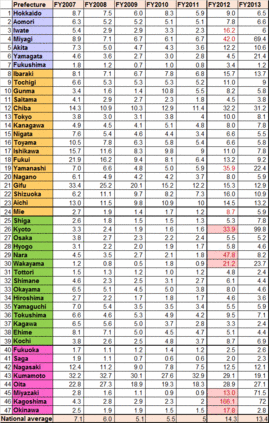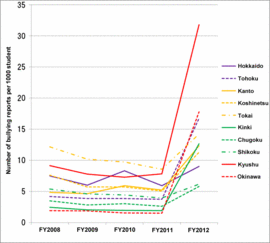Anatomy of Child Bullying in Japan
- 1. Definition of Bullying and its Transformation
- 2. Bullying in Different Cultures - Differences and Similarities in Bullying Between Countries
- 3. Bullying and the Relation to Teacher Leadership
- 4. Bullying Prevention (1): Preventing Bullying Caused by "Negative Conformity"
- 5. Bullying Prevention (2): Preventing the Escalation of Bullying by Recognizing Children's SOS Signs
- 6. Bullying Prevention (3): How to Interpret the Anti-Bullying Act
- 7. Bullying Prevention (4): What Should We Expect from Bullying Prevention Programs?
- 8. Bullying Prevention (5): Bullying Prevention Program by the Tokyo Metropolitan Government
- 9. What Does the Number of Bullying Reports Imply? An Analytical Study Based on Data from across Japan (This article)
- 10. Anatomy of Child Bullying in Japan 10: Effects of the broader definition of bullying
The Number of Bullying Reports Varies According to the Degree of Public Attention and Bullying Prevention Initiatives
The number of bullying reports is not equivalent to the actual number of bullying incidents. Although the actual number of bullying incidents should not vary so much between fiscal years or prefectures, the number of reported bullying incidents during each fiscal year differs greatly with a wide disparity among prefectures.
How large is the actual difference between regions or years? Table 1 shows the number of bullying incidents reported per 1000 students in each of the administrative districts of Japan, while Figure 1 shows the number of bullying incidents reported per 1000 students in each region for the period between FY2008 and FY2012. (In particular, the number of reports in the Kyushu region increased sharply between FY2011 and FY2012, reflecting a sharp increase in the number of reports in Kagoshima Prefecture as shown in Table 1). Since the official definition of bullying was changed in 2007 (see "Anatomy of Child Bullying in Japan 1"), the number of bullying reports has surged, making it difficult to simply compare the survey data before 2007, which is why Table 1 only shows survey data from FY2007 to FY2013). As you see, the number of reported cases increased sharply between FY2011 and FY2012 in Figure 1. In order to highlight the disparities shown in Table 1, figures that increased by 10 times or more between FY2011 and FY2012 are shown in red and highlighted in pink, and those that increased by 5 times or more and by less than 10 times are shown in red.
 |  *Click images to enlarge |
| (Left) Table 1: Number of bullying reports per 1000 students by prefecture (Right) Figure 1: Number of bullying reports per 1000 student by region per annum | |
In the past, the number of bullying reports tended to increase when bullying was the center of public attention after serious bullying incidents had occurred, and when the Ministry of Education, Culture, Sports, Science and Technology (MEXT) introduced a new official definition and initiatives for bullying in response to public interest. For example, after the bullying incident that occurred in Otsu in 2011 stirred up a great deal of controversy, many schools conducted questionnaire surveys and implemented measures to detect and prevent bullying. As a result, the number of bullying reports increased from the national average of 5 per 1000 students in FY2011 to 14.3 (increased by nearly 3 times) in FY2012. In terms of regional differences, the lowest numbers of reported cases were 0.6 per 1000 students in Saga Prefecture, 0.8 in Fukushima Prefecture, and 0.9 in Wakayama Prefecture and Miyazaki Prefecture, while the highest was 32.9 per 1000 students in Kumamoto Prefecture in FY2011. In contrast, in FY2012 after the Otsu incident, the lowest levels of reported cases increased to 2.0 per 1000 students (increased by 3.3 times from FY2011) in Saga Prefecture and 3.4 (increased by 4.3 times from FY2011) in Fukushima Prefecture, while the highest level of reported cases increased sharply to 166.1 per 1000 students (increased from 2 in FY2011 by 83 times) in Kagoshima Prefecture. When focusing on Shiga Prefecture where the Otsu incident occurred and its neighboring prefectures, the number of reports increased from 1.3 to 5.3 per 1000 students (increased by 4 times from FY2011) in Shiga Prefecture, while the number of reports surged from 1.6 to 33.9 (increased by more than 20 times from FY2011) in Kyoto Prefecture and from 1.8 to 47.8 (increased by more than 25 times from FY2011) in Nara Prefecture.
It is understandable that schools and local governments prefer to keep the number of reports as low as possible, avoiding the risk of damaging their reputation. For example, an area where the number of reports is high would be viewed as a "bullying hot spot" or an area where "bullying issues are not addressed properly." On the other hand, it is also assumed that the high number of reports reflects the earnest efforts of schools and local governments to address bullying issues, since it takes courage for them to disclose the high figure of reported cases considering the above risk of a damaged reputation. It should be noted, however, that the low number of reports does not necessarily indicate that bullying issues are not addressed properly. In fact, there are many cases where schools and local governments achieved the low number of reported cases due to their persistent efforts to prevent bullying incidents *.
The Relationship Between Problematic Behavior of Teachers and the Number of Bullying Reports: The Lower the Compliance of Teachers, the Lower the Number of Bullying Reports?
Although the low number of bullying reports may be the result of well-managed anti-bullying measures, there are insufficient data to deny the possibility that "schools and local governments maintain a passive attitude towards the prevention of bullying, and teachers are unaware of the seriousness of bullying issues" in those areas showing low numbers of reports. Therefore, I have developed and tested a hypothesis: "the higher the number of teachers with problematic behaviors (or low-compliant teachers) the lower the number of bullying reports in that prefecture." This hypothesis was developed with Mr. Fumiaki Taka, a member of my research laboratory. Mr. Taka and Ms. Meika Kanekatsu (graduate student) collected data and conducted the analysis.
This study consists of two approaches: (1) analysis of data collected from MEXT (the rate of reported cases of bullying, and the rate and degree of disciplinary punishments given to teachers); and (2) analysis of data collected from the Ministry of Justice (MOJ), which has little conflict of interest with MEXT, in addition to the data of MEXT.
Study One: Analysis on data collected from MEXT
We have calculated the following figures based on the statistical data between FY2007 and FY2013 published by MEXT: (1) the percentage of bullying reports out of the total number of students (report rate); (2) the percentage of teachers who received disciplinary punishment out of the total number of teachers (disciplinary punishment rate of teachers); and (3) the percentage of serious disciplinary punishment against the total number of disciplinary punishments given to teachers (ratio of serious punishment).
As a result of our analysis, we have identified the following facts (the analysis was conducted mainly on the average main effect and interaction effect of disciplinary punishment given to teachers per year and the prefectural average as well as the hierarchical linear model with a dummy variable (as an explanatory variable) indicating the timing of punishments before/after the Otsu incident which drew public attention in 2012; and then, simple slope analysis was conducted due to the significance of the interaction effect between the disciplinary punishment rate of teachers and the rate of serious punishments per prefecture).
First, it was revealed that the higher the disciplinary punishment rate of teachers, the lower the report rate of bullying in a prefecture where teachers often receive relatively minor punishments (i.e., the ratio of serious punishments is low). In contrast, in prefectures where teachers often receive serious punishments (i.e., the ratio of serious punishment is high), there is no relationship between the high disciplinary punishment rate of teachers and the report rate of bullying.
Study Two: Analysis of data collected from the MOJ and MEXT
The statistical data of teachers disciplined, which were used for Study One, are figures reflecting the discretionary power of the board of education, etc. Therefore, the high disciplinary punishment rate of teachers could possibly indicate the efforts of local governments to maintain a good level of compliance for teachers.
Therefore, in Study Two, we conducted the same analysis employed in Study One using the number of consultations regarding human rights submitted to the MOJ as an explanatory variable (reflecting the number of cases where the response of schools and education committees to the improper behavior of teachers was not satisfactory).
More precisely, we calculated the following figures in addition to the "report rate" based on the statistical data of MEXT and the MOJ, which are to be used for the same analysis employed in Study One: (1) the percentage of consultations for bullying out of the total number of students (the "rate of bullying consultation"); (2) the percentage of consultations for physical punishment out of the total number of teachers (the "rate of physical punishment consultation"); (3) and the percentage of consultations for human rights violations (excluding physical punishment) out of the total number of teachers (the "rate of other consultation").
The results of the statistical analysis on the relationship between variables (using a hierarchical linear model) revealed that in prefectures where the number of consultations for physical punishment were high, a lower number of bullying incidents was reported.
The results of statistical analyses in both Study One and Study Two indicate a significant correlation: the "higher the disciplinary rate of teachers, the lower the report rate of bullying." However, this does not indicate that a "higher disciplinary rate of teachers definitely results in a lower report rate" or any "prefecture where the report rate is low definitely shows the higher disciplinary rate of teachers." The fact that many teachers receive serious disciplinary punishments in a certain prefecture might suggest the high level of compliance of teachers in that area. In this case, measures for preventing bullying might be taken aggressively.
In Study One, there is no relationship between the disciplinary rate of teachers and the report rate in a prefecture where teachers often receive serious punishment. In Study Two, the high rate of consultation for human rights violations such as physical punishment by teachers submitted to the MOJ is related to the lower report rate of bullying. (This does not mean that physical punishment by teachers occurs frequently in a prefecture where the report rate is low, but only suggests that there may be some prefectures where the report rate is low under such circumstances). Therefore, it is assumed that there are some cases where teachers who often use physical punishment tend to become insensitive and overlook bullying situations, or the act of such teachers itself may lead to the underestimation of bullying problems and encourage bullying behavior.
Besides the above results, the data by fiscal year/prefecture should be analyzed from various aspects. There is the possibility of serious misinterpretation unless we understand the actual processes of analysis and decisions made by those involved.
- * Let me provide some theoretical explanations for the above analysis results. The proposition "If A (the number of reports is high), then B (bullying is earnestly addressed)" is not equivalent to the proposition "If not A (the number of reports is low), then not B (bullying is not earnestly addressed)." This is because the proposition "If A, then B" indicates that "A is included in B," but also indicates that "as long as A (the number of reports is high) is included in B (bullying is earnestly addressed), Not A (the number of reports is low) can be included in B as well. Therefore, it is a logical error to say "If not A, then not B" based on the assumption "If A, then B." In mathematical jargon, "A" is called antecedent and "B" consequent; therefore, it is known as the "fallacy of denying the antecedent." We often see this common error of "fallacy of denying the antecedent" made by many educationists in various aspects.



 Dr. Sugimori is Professor of Social Psychology at Tokyo Gakugei University, conducting research on group psychology (evaluation of team working, psychology in the citizen judge system, and effects of experiential activities) as well as risk psychology, from the standpoint of cultural social psychology focusing on social relations between individuals and groups. He also serves as Board Member of the Japanese Society for Law and Psychology; Executive Board Member of the Society for Field-Culture Education; Board Member of the Youth Friendship Association; Councilor of the Outward Bound Japan; Board Member of the Children Institute for the Future, Tokyo Gakugei University; Chairman of the Accreditation Committee, Japan Association for Certifying and Training Educational Specialists.
Dr. Sugimori is Professor of Social Psychology at Tokyo Gakugei University, conducting research on group psychology (evaluation of team working, psychology in the citizen judge system, and effects of experiential activities) as well as risk psychology, from the standpoint of cultural social psychology focusing on social relations between individuals and groups. He also serves as Board Member of the Japanese Society for Law and Psychology; Executive Board Member of the Society for Field-Culture Education; Board Member of the Youth Friendship Association; Councilor of the Outward Bound Japan; Board Member of the Children Institute for the Future, Tokyo Gakugei University; Chairman of the Accreditation Committee, Japan Association for Certifying and Training Educational Specialists.










